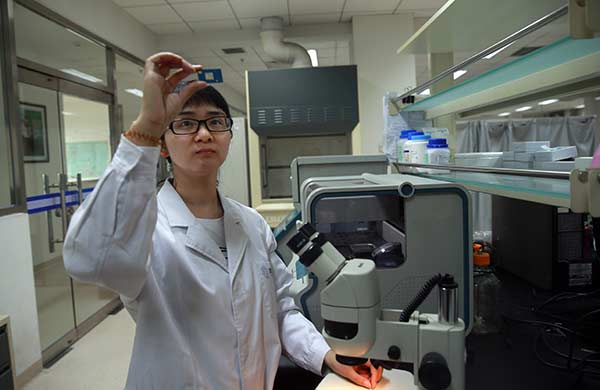
"We hope to separate a single test - such as the one to assess the movement of sperm - from the biochip that tests the quality of sperm and embed it in a portable device, similar to a pregnancy testing kit. People only need to collect a few drops of semen. The method is as simple as the pregnancy testing kit," she said.
Unlike biochips that require a specific power supply, the three new biochips can be used in any lab. Patients only need to provide samples to the medical professionals.
The samples are carried to the biochip via a pipette - a tool used for liquid transportation in chemistry, biology and medicine.
Once in the biochip, the activity of the sperm and eggs can be studied through a microscope to provide a clear picture of the interaction.
Quality, not quantity
Because most healthy men can produce large amounts of sperm - 1 milliliter of semen contains more than 15 million sperm on average - the quality attracts less attention than problems related to human eggs.
However, clinical research shows another side to the story.
Peking University Third Hospital - the country's leading center for infertility problems - studied notes collected between 2004 and 2008 about more than 50,000 cases.
The results of the research indicated that the proportion of viable sperm in each milliliter of semen declined from 47.27 percent to 32.97 percent over the four-year period.
Moreover, the number of patients with a negligible sperm count rose from 6 to 10 percent, while those with a low sperm count rose from 60 to 85 percent during the same period.
Last year, more than 125,000 patients attended the hospital's andrology department. The number was six times higher than in 2009, and about 50 percent of the patients had infertility problems. "After the relaxation of the family planning policy, the number of patient visits has climbed by nearly 30 percent," said Jiang Hui, the director of the department.
"More men are facing fertility problems, despite a rise in the number of medical staff available to treat them, and people's increasing awareness of reproductive health," Jiang said. "A number of factors are to blame, including environmental pollution and the pressure of work."
Three basic tests
The fusion of a sperm and an egg is the beginning of human life. The health of sperms and eggs is equally important, irrespective of whether the child is conceived via natural conception or through the use of human-assisted reproductive technologies.
In most public hospitals, sperm testing and evaluation mainly focus on three basic functions: sperm count, motility (the sperm's ability to move), and morphology (the shape and appearance of the sperm).
The development of medical science has resulted in the discovery of a wide range of factors that determine whether a sperm can find the egg and swim in the right direction to achieve a successful union.
"The uterus is like a big maze. To swim from the vagina to the fallopian tubes and find the egg is never a coincidence," said Xie Lan, a researcher at Tsinghua University who led the design of the biochips. "In the process, the sperm's chemotaxis (the movement of organisms as a reaction to chemical stimulus) and thermotaxis (movement of an organism toward or away from heat sources) are the other two major factors."


















































